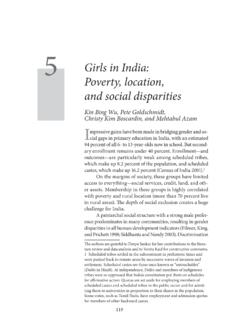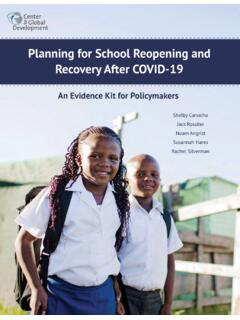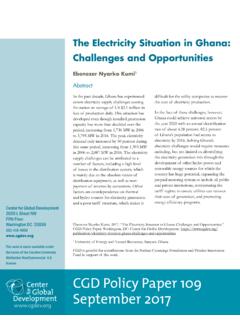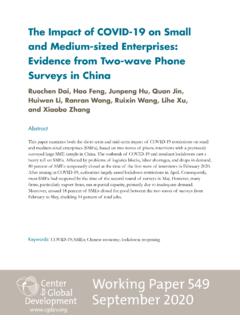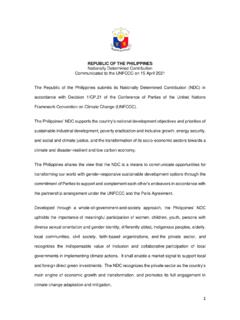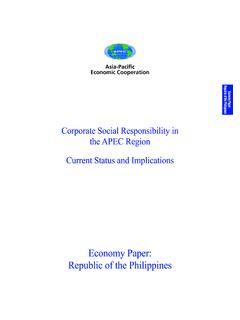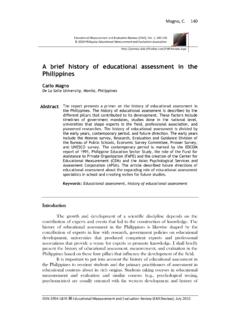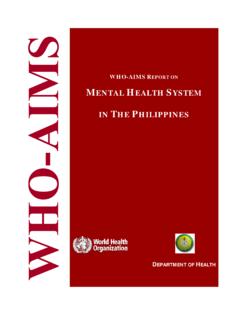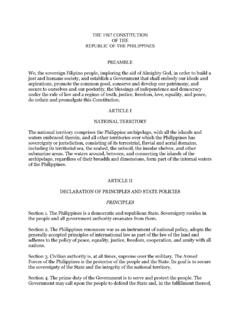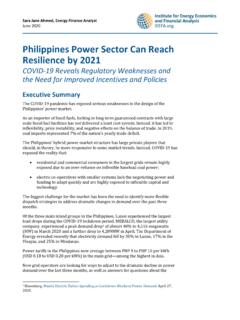Transcription of Health Systems Impact of COVID-19 in the Philippines
1 Health Systems Impact of COVID-19 in the Philippines Diana Beatriz S. Bayani and Soon Guan Tan Abstract Lockdowns and policy actions to curtail the transmission of COVID-19 have widespread Health system , economic, and societal impacts. Health Systems of low-to-middle-income countries may have fewer buffering resources and capacity against shocks from a pandemic. This paper presents a preliminary review on the collateral Health Systems Impact of COVID-19 in the Philippines through review of academic and grey literature, supplemented by a qualitative survey. Community quarantines alongside transport and boarder restrictions have universally impacted Health service access and delivery, affecting patients requiring specialist care the most. Existing record-keeping and surveillance measures were hampered as existing resources were tapped to perform covid - 19-related tasks.
2 Local Health Systems reinforced gatekeeping mechanisms for secondary and tertiary care through referral Systems and implemented telemedicine services to reduce face-to-face consultation. The Health system impacts in the Philippines have been variegated across municipal income class and topography, contributed by long-standing symptoms of inequitable resource allocation. JEL: I18. Working Paper 569. March 2021. Health Systems Impact of COVID-19 in the Philippines Diana Beatriz S. Bayani and Soon Guan Tan Saw Swee Hock School of Public Health , National University of Singapore Corresponding author: Diana Beatriz S. Bayani, This work is part of a multi-country project that is seeking to understand the nature, scale, and scope of the indirect Health effects of the COVID-19 pandemic. The project is managed by the Center for Global Development.
3 We are grateful for the inputs of Damian Walker, Carleigh Krubiner, Y-Ling Chi, Lydia Regan, throughout the conceptualization, analysis, and synthesis of this work. We also thank Christian Nuevo and Yot Teerawattananon for their useful comments on earlier drafts. Contributions to this work were generously supported by Open Philanthropy and by the International Decision Support Initiative (iDSI). Diana Beatriz S. Bayani and Soon Guan Tan, 2021. Health Systems Impact of COVID-19 in the Philippines . CGD Working Paper 569. Washington, DC: Center for Global Development. 19- Philippines . Center for Global Development The Center for Global Development works to reduce global poverty 2055 L Street NW and improve lives through innovative economic research that drives Washington, DC 20036 better policy and practice by the world's top decision makers.
4 Use and dissemination of this Working Paper is encouraged; however, reproduced copies may not be used for commercial purposes. Further usage is (f) permitted under the terms of the Creative Commons License. The views expressed in CGD Working Papers are those of the authors and should not be attributed to the board of directors, funders of the Center for Global Development, or the authors' respective organizations. Contents Foreword .. 1. Introduction .. 2. Country Profile .. 3. Health Systems Context .. 3. Materials and Methods .. 5. Conceptual Framework .. 5. Methods .. 6. Data analysis .. 7. Results .. 7. Overview of COVID-19 Situation & Mitigation Strategies 7. Health Systems Impact of COVID-19 Mitigation Strategies .. 11. Discussion and Conclusions .. 16. References .. 18. Foreword On March 11, 2020, the World Health Organization declared COVID-19 a global pandemic.
5 With dire predictions about how the virus could devastate populations and overwhelm Health Systems , many countries imposed stringent measures to limit spread and the resulting morbidity and mortality. Yet most of these policy approaches focused narrowly on potential impacts for COVID-19 , without sufficient attention to how the pandemic and various response measures would have broader indirect impacts across other Health needs and Health services. While the evidence of disruptions to essential Health services was largely anecdotal to begin with, and its Health effects mostly modeled, increasingly detailed evidence is beginning to emerge from countries. Over the past year we partnered with research institutions in Kenya, the Philippines , South Africa, and Uganda to document, from a whole-of- Health perspective, what we know about the nature, scale, and scope of the disruptions to essential Health services in those countries, and the Health effects of such disruptions.
6 This research provides initial insights on the observed near-term indirect Health impacts of the pandemic and response measures, relying on the best available data in the months following lockdown measures. However, it is important to recognize the limitations of conducting research during a pandemic and a continuously evolving epidemiological and policy context. We plan to build on these studies as more and better data become available, and as public Health responses continue until the pandemic is brought under control. In this paper, Diana Beatriz S. Bayani and Soon Guan Tan present findings on the collateral Health system impacts of COVID-19 and its mitigation strategies in the Philippines . They show us that the story is nuanced; disruptions vary by service, by geography, and by sub- populations. They also remind us that evidence of disruptions today is a leading indicator of Health effects in the future.
7 We are hopeful that the findings from this working paper and the project as a whole will contribute to our global knowledge about the ongoing and lingering effects of the pandemic, and ways to mitigate these effects. It is not too late for action. Armed with the kind of evidence in this working paper, national governments and global partners must focus their efforts on the most affected, most cost-effective services, and ensure that any lost generations due to the pandemic are minimized. Carleigh Krubiner Policy Fellow Center for Global Development Damian Walker Non-Resident Fellow Center for Global Development 1. Introduction Governments across the globe are increasingly reliant on outputs of disease modelling to assess the risk of a pandemic and the cost-benefit of action (or inaction) to mitigate novel Health threats.
8 The use of models to inform suitable policy response was particularly evident in light of response against the COVID-19 pandemic (1 4). However, to date, models have had a near singular focus on COVID-19 cases and deaths and have not accounted for the vastly different contexts of countries, including the trade-offs and economic shocks that greatly affect how mitigation strategies translate to lives saved, especially in low- and middle- income countries (LMICs) (5). Most existing models were not designed to contextualise impacts on the wider Health care system and so, do not capture indirect Health effects of policies; the knock-on or collateral Health effects. This omission is not without consequences. Past pandemics and outbreaks have produced substantial evidence on the indirect Health Impact such as secondary mortality arising from policy interventions (6).
9 During the 2014-2015 Ebola crisis in West Africa, it was estimated that a 50 per cent reduction in access to services led to an additional 10,600 deaths just from malaria, HIV/AIDS and TB almost equal to the 11,300 deaths directly caused by Ebola (7). Nearly a year into the pandemic, there has been substantial evidence and reports detailing the indirect Health impacts of lockdowns and travel restrictions (8 11). Beyond impacts in the Health Systems alone, it is clear that repercussions of policy actions can ripple into the social, behavioural, economic and environmental domains in society that translate to Health outcomes immediately and in the long run. LMICs in particular, may be disproportionately impacted due to the fragility of Health Systems with limited capacity and resources to buffer against shocks (12).
10 There is a need to understand the indirect effects of not just the pandemic itself, but also unintended effects of mitigation measures that have been adopted to contain it. This knowledge can allow for context-specific, tailored mitigation and suppression strategies to be considered, with the dual goals of controlling the epidemic and averting the worst direct and indirect Health impacts. At present, much of the literature and focus has been on the effect of mitigation measures on COVID-19 cases, deaths, testing capacity and other COVID-19 related-metrics. However, there have been limited attempts to understand how these pandemic mitigation measures, applied within the context of an LMIC, can Impact different aspects of the Health Systems and thus, the population Health . Thus, this paper aims to present a preliminary review of the collateral Health Systems Impact of COVID-19 and its mitigation strategies in the Philippines .

